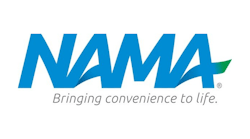The industry is experiencing a shift and NAMA leaders are blazing the way. The national association’s CEO, Carla Balakgie, calls it the story of “convenience services.” This phrase is not just behind the updated NAMA tagline “bringing convenience to life,” but, also the vision she holds of the industry and its future.
“It’s both making sure people understand what we do today, and that is has changed from the past,” Balakgie began as she explained the impact of convenience services. “It is also trying to describe what it could be: to industry members, those who should be involved in our industry and those of influence such as political officials and media.”
This view of an industry that is so much more than it used to be is held by the 2018 NAMA Chair, Heidi Chico, CEO of The Wittern Group, based in Des Moines, IA, as well. “Broadening our horizons has already been a fundamental part of the journey, but we’re really bringing that to the forefront in this coming year,” she said. “We will be talking about convenience services in a much broader sense than what we’ve done in the past.” The industry can expect these discussions to include diversification on multiple levels, from helping to provide convenience services to the workplace as well as the consumer and also to help educate members on how to think outside what has been traditional or normal. “We have a lot of things on our agenda this year to put that into play,” Chico finished.
Convenience services defined
NAMA embraced the term “convenience services,” because it better defined all the different types of offerings brought to locations across the country by the association’s members. “It is that we are serving you with convenience,” said Balakgie. “We are bringing it to you. It’s a distinguishing feature if you think about other aspects of convenience, such as a convenience store where you go to them.”
It’s an important nuance because it leads to consumer empathy, identifying what consumers want and need, and then how the industry can bring it to them. In many ways, the vending, micro market and office coffee service providers are already doing this. They are refreshing consumers, nourishing them. However, Balakgie believes it goes beyond this. “How do we help companies meet their fitness goals? What can we do to help keep employees on premise? How can we use our network to deliver the things that make life easier?”
Balakgie put such emphasis on the word deliver, that the entire conversation changed to one of a future where operators are meeting a need in the distribution chain commonly called “the last mile.”
“I think when you talk about convenience services, you need to talk about the opportunities and changing trends, even from a small drop distribution perspective,” said Chico. When she visits customers, she sees changes, modest, but telling. These changes are specifically around what is being carried in warehouses to accommodate consumer and employer trends, such as exploding health and wellness requests.
As what consumers what and need shifts, it leaves the industry in a state of shift as well. “We are defining it as we go,” said Balakgie. “We know where it is today and the places where we think it’s going to go, but it’s unfolding.”
“We have outside threats to our industry, such as UberEats and Amazon,” said Chico. “From a board and association perspective, we are really challenged with how to adapt to that and scale it in a profitable way for our members.” One of the things that has changed is how The Wittern Group regards its business. “We no longer consider ourselves a vending machine manufacturer,” indicated Chico. “We in effect redefined who we are as ‘controlled dispensing’.”
The reason for this change is the increased use of vending machines in nontraditional areas, from selling beauty products in malls to managing medical supplies in hospitals. Wittern actually has many “managed controlled dispensing” systems in the field that act as retail spaces for products and services. Some of these vending machines allow users to recharge electronics while others control the distribution of items from band-aids to morphine. As of right now, these nontraditional aspects of automated retail are beyond the core of convenience services, but Chico is quick to point out that it might not be that way forever. “Never say never,” she said.
Small drop distribution
“Really, what I think the industry does well is small drop distribution,” said Chico, and that is where she sees the future for this industry. She hopes operators can broaden what they already do, the application of delivering products and services to the end user, by looking at the process of distribution. If they are able to find ways to drop ship components to fill machines, while not having the cost of carrying all those SKUs in the warehouse, it could be very lucrative.
This is in line with what Balakgie sees as well. “If you can get away from so much cost sunk into inventory, yet you are able to access inventory, then what else you could sell or serve becomes a completely different discussion,” she added. Expensive items, such as high-end headphones for example, become an option as the operator would not have to buy and store them.
“It’s letting the distribution model do the prekitting,” said Chico, “to drive your business so your warehouse space is not a burden. You are utilizing your distribution center, almost making your distribution center an Amazon.”
Balakgie cites an example that she thinks speaks to how this idea could work for operators — the experiment between Kohls and Amazon. Kohls department store chain has allowed online shopping mogul Amazon to set up a center inside 10 of its brick and mortar stores. Part of the agreement is to allow Amazon to focus on its smart home suite of products, but more importantly, at least for this industry, is that the agreement also allows customers to return purchases made from Amazon at no cost (instead of having to pay to get the item shipped back).
“What Amazon found was a way to take a physical presence and have them be their customer interaction or service unit,” said Balakgie. Service is an important consideration. Balakgie argues that Apple stores are a prime example of a place customers go as often for service as to buy products. “In our industry, it’s about service too,” said Balakgie. “I continue to believe that is what distinguishes us.”
Reinvention requires vision
It will take a multifaceted approach, a clear plan and strong leadership to guide the industry on its broadening path from vending to a wider range of service offerings including being retail and delivery focused.
“It’s our job at NAMA to be foresighted,” said Balakgie. “If you aren’t paying attention to the changes happening, you are already losing ground.” At the same time the association has to meet operator’s needs of today, all while still looking far forward. “We have this dual, Janis-faced responsibility of providing them what they need now, and alerting them to what they’ll need much farther out,” Balakgie added.
It’s important to have a strategic plan, adds Chico. “Having that vision is part of the process of providing convenience services and supporting those members. The story has to be told over and over, but first you have to have a vision.”
Vision was on the agenda in December as NAMA held its second executive forum. “The idea [behind the executive forums] is to bring C-suite individuals into an environment where they can talk about organization leadership, individual leadership and marketplace leadership,” Chico said. She believes nothing helps to formalize vision and a strategic plan better than formalizing a message through the industry leaders. “It’s going to take leaders in our industry to drive that change,” Chico added.
NAMA is becoming a more proactive organization, something it could not boast about a decade ago. Chico, who has been on the board for 12 years, has seen firsthand the changes happening. Years ago, NAMA was fighting the U.S. Mint about how the coin metals might be changing, and reacting to the attacks on vending machines as junk food purveyors. “Today, we are beyond that,” she said. “We are into our own zone of recognizing how we serve the customer better, and what arrows we need in our quiver to help drive it more proactively, efficiently and profitably into the future.”
Is NAMA and the entire industry at a pivotal point? “When you are in the midst of something, it’s difficult to have perspective,” said Balakgie, “but I see little things along the way that tell me change is happening faster. Still gradually, but faster than I thought it would.” She describes the shift as going through a trough — beating the economic downturn, the pessimism and lack of investment. “We are back up to the top of the curve and I think there is a breakthrough ahead, in 2018 or maybe the next year, but ahead.”
The New NAMA
While NAMA has brand recognition in the industry, the organization is so much more than it was years ago. Heidi Chico, who has been on the NAMA board for 12 years, remembers a time when members felt they had seen all NAMA had to offer. “It’s our job to keep the message on point and help the members see value in what we’re offering,” Chico said. For her this means advocacy, fighting against the sweetened beverage tax, which has brought a lot of members together. It means changing the perception of vending machines. A vending machine was considered to carry only junk food, but now has the opportunity to be a controlled dispensing solution. “A controlled dispensing solution can monitor what access consumers might have. It could be at an elementary school,” suggested Chico, “where there are kids that can’t have peanuts or mom and dad don’t want them to have a sugary snack. Controlled dispensing allows the flexibility for parents to remotely control what access their children have to items in the school environment.”
NAMA also brings a tremendous amount of value to its members’ businesses, according to Chico. “The way I try to describe the value it brings is to think of it in terms of outside advisers, such as an accountant or legal team,” she said. “NAMA is your advocacy arm, so invest in NAMA because NAMA can be there when times get tough. And I’ve seen it over 12 years. It’s a great organization to learn from others, but it’s also a great organization to help protect your business.”
Empowered Workforce
The coming year marks the first time in NAMA history there is a female chair of NAMA, Heidi Chico. This makes two strong female leaders at the forefront, as Carla Balakgie remains the first ever female CEO of the organization. While both Balakgie and Chico are honored to be the first, neither says that it was their intent. They both feel the zeal for the industry and vision of its future transcend gender.
“I think that perhaps there are signals that it sends that are really positive,” said Balakgie. “If nothing else, it encourages other woman to be leaders in the industry.”
Chico agreed. “I’m proud the board members elected me and I’m proud to be the first woman chair,” she said. “I think I am just the first of many to come.”

Emily Refermat
Emily began covering the vending industry in 2006 and became editor of Automatic Merchandiser in 2012. Usually, Emily tries the new salted snack in the vending machine, unless she’s on deadline — then it’s a Snickers.
Emily resigned from Automatic Merchandiser and VendingMarketWatch.com in 2019 to pursue other opportunities.






